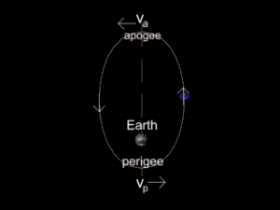


![]() What has angular momentum to do with the XMM's orbit?
What has angular momentum to do with the XMM's orbit?
![]()
XMM's orbit takes it a distance from the Earth equivalent to almost a third of the distance to the Moon. Because it spends so much of its time well away from the Earth its orbit is very stable and the consumables on-board XMM will have been used up long before such an orbit decays. Hence we can think of XMM as being "parked" in an orbit. This is possible only because it has angular momentum.
Had the Earth not been spinning and had XMM been launched vertically upwards (i.e. radially along a line through the centre of the Earth) at a velocity less than its escape velocity, it would have fallen back to the Earth's surface at the spot from which it was launched. Given a bit of tangential velocity parallel to the ground it would have fallen in that direction. Given some more and eventually, because the Earth is round, by the time it has fallen the ground is no longer there to receive it and it has gone into orbit.
Because the Earth spins on its own axis such that a point on the ground already has a component of velocity in the West to East direction, most satellites are launched in this direction. Show that at the equator this velocity is about ½ km/sec which is not insignificant. Click here for the answer.
Angular momentum is conserved round the orbit. At perigee (the minimum distance between the satellite and the Earth) and apogee (the maximum distance between the satellite and the Earth) the satellite velocity is perpendicular to the imaginary line between the satellite and the centre of the Earth.

Hence, for conservation of angular momentum,
m.va(distnce form apogee point to center of Earth)
= m.vp(distnce form perogee point to center of Earth)
Thus

Given the XMM perigee and apogee of 7000km and 114000km and the radius of the Earth of about 6400km, this gives

We can see from this that the velocity of XMM round the orbit changes by about a factor 10. The perigee velocity is its velocity at injection which is of order 10 km/sec and the above shows that this velocity has reduced to about 1 km/sec at apogee. Hence XMM spends most of its time far away from the Earth because it is travelling more slowly. This is useful because close to the Earth there are the Van Allen radiation belts whose energetic, trapped particles make the XMM detectors very noisy. Observations are not made during this time of close approach which lasts about 8 hours compared with the XMM orbital period of 48 hours.
[for more information on XMM's orbit see spdext.estec.esa.nl/content/doc/b3/14515_.htm]
Not only does angular momentum keep XMM in orbit by virtue of the fact that it allows XMM to keep falling to the Earth without actually reaching it, but in a similar way it also helps keep the matter in the Universe from falling in on itself. Thus we have systems which are stable over billions of years such as planetary systems, clusters of stars, galaxies and clusters of galaxies.

